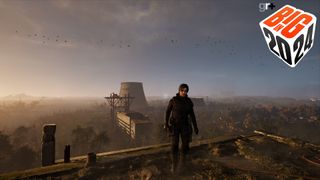
Stalker 2: Heart of Chornobyl is less of a sequel and more of a culmination, the climax of a story that's been two decades in the telling. GSC Game World's sequel is actually the fourth game in the series, which first registered on the Geiger-Counter back in 2007 with Shadow of Chernobyl.
The original Stalker was way ahead of its time, but also got somewhat ahead of itself. In an era when first-person shooters were still resolutely linear, Shadow of Chernobyl let players freely explore huge chunks of Ukraine's Exclusion Zone, the abandoned, irradiated landscape that surrounds the decommissioned Chernobyl Nuclear Power Plant. It featured authentic, uncompromising combat, and toyed with survival systems that wouldn't come into vogue for another half-decade.
Yet it was also a compromised vision, with many planned features being cut from the final game, and its contiguous open world split into different chunks. GSC spent the next two games adding in ideas that had to be cut from the original, like dynamic factions and deadly emissions, intense radioactive blasts that cover the entire Zone. Yet even 2009's Call of Pripyat, the most feature-complete game in the series, still split its world into two distinct parts.
Stalker 2, now due on September 5 this year, aims to be the game that Shadow of Chernobyl was always meant to be. Powered by Unreal Engine 5, the sequel takes place in a 64km-squared chunk of the exclusion zone, which will include the power plant itself and the Soviet-era ghost city of Pripyat.
In the zone


GamesRadar+ is exploring the most anticipated video games of the year with Big in 2024, with new articles dropping every day throughout January.
While there isn't a huge amount of info available about the game's story, it is a direct follow-up to Shadow of Chernobyl, with you playing as a new Stalker known as "Skif". The sequel aims to include all the key features of previous games. You'll be exploring the open world, both on the surface and through subterranean facilities, seeking out valuable artefacts that can be sold in exchange. To secure these artefacts, you'll need to avoid dangerous anomalies like powerful gravitational bubbles that can tear unwary Stalkers apart, fend off mutant wildlife, and battle bandits and other Stalkers belonging to different factions. The game also features several systems introduced only in later games, like Call of Pripyat's deadly emissions, alongside ideas that were originally intended for the game but never included, like hunger and fatigue simulation, which requires players to eat and sleep to survive.
Stalker's goal has always been to immerse you in its bleak and brutal world, and the sequel seeks to enhance that immersion in numerous ways. Alongside the seamless environments and substantially improved visuals, the various trailers place considerable emphasis on the game's first-person animations clearly intended to ground you in the world, like using consumables such as drinks and bandages, and even for swapping weapon attachments like scopes. There's also a new version of the original game's "A-life" system, which governed the behaviours of its mutants and human NPCs as they roamed the world regardless of the player's presence. It's hard to judge how effective this system will be from available footage of the game, but GSC says it will see factions and mutants battling over "living space, migrating, capturing new places, or retreating to safer areas".
On the subject of weapons, expect Stalker 2's combat to lean toward realism and simulation, where headshots are an instant kill, for both you and your enemies. GSC says there are "30+ types of weapons" in the game, which can be further modified with attachments like scopes and silencers. GSC certainly knows how to create a tense, thrilling combat system, so it's exciting to imagine what the studio can pull off with today's tech.
Sign up to the GamesRadar+ Newsletter
Weekly digests, tales from the communities you love, and more
All signs point to Stalker 2 being a comprehensive implementation of the series' ideas. One question that remains unanswered is whether GSC can smooth out the jank present in earlier games. Early previews from Gamescom last year praised the game's gunplay and immersive qualities, but noted the build was very buggy. In fairness to GSC, however, it must contend with the unprecedented complication of developing its game in an active war zone. After Russia's invasion of Ukraine, some of GSC's designers relocated to the Czech Republic, but others remained in Kiev, while a few designers have joined directly in the defence of Ukraine.
To release a game at all in such a situation is a remarkable achievement, not least one as fundamentally complex as Stalker. Nonetheless, if GSC can deliver a more polished experience than previous games, then Heart of Chornobyl stands every chance of being one of the highlights of 2024.
GamesRadar+ is exploring the most anticipated video games of the year with Big in 2024, with new articles dropping every day throughout January.
Rick is the Games Editor on Custom PC. He is also a freelance games journalist whose words have appeared on Eurogamer, PC Gamer, The Guardian, RPS, Kotaku, Trusted Reviews, PC Gamer, GamesRadar, Rock, Paper, Shotgun, and more.
Most Popular



